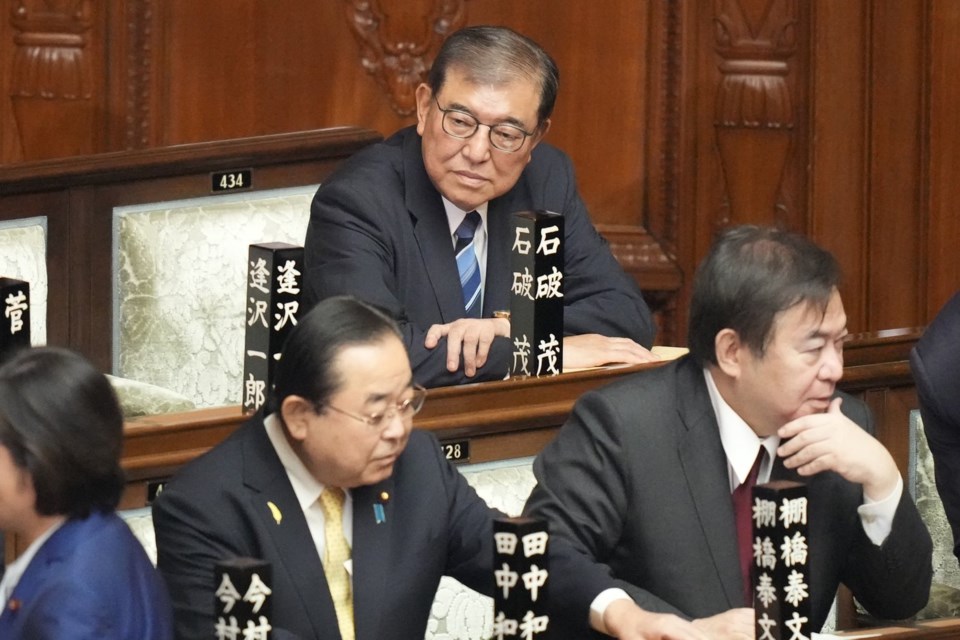TOKYO (AP) ÔÇö Japan's parliament elected as the new prime minister on Tuesday, tasked with addressing public outrage over his governing party's corruption scandals ahead of a parliamentary election later this month, while trying to boost the economy and tackle security challenges from China and North Korea.
Ishiba replaces , who stepped down earlier Tuesday to pave the way for a fresh leader after Kishida's government was dogged by scandals.
Ishiba entered the Prime Minister's Office and formed his Cabinet, which includes several security and defense experts, as he has called for a stronger regional military alliance and a more equal Japan-U.S. security partnership.
Ishiba will hold a news conference later Tuesday to announce his Cabinet and some of his policy priorities.
Ishiba said he plans to call a parliamentary election for Oct. 27 so his new administration can have ÔÇ£the people's judgementÔÇØ as soon as possible.
Ishiba appointed to his Cabinet two former defense ministers with whom he has worked closely ÔÇö Takeshi Iwaya as foreign minister and Gen Nakatani as defense chief ÔÇö underscoring his emphasis on defense and security policies.
Only two of the 19 ministers are women: actor-turned-lawmaker Junko Mihara as childrenÔÇÖs policy minister and Toshiko Abe as education minister. The government is under pressure to increase the number of women in public office. Women now account for only 10% of the lower house, placing Japan near the bottom of global gender-equality rankings.
Ishiba appointed several ministers who voted for him in the party leadership poll and retained Kishida's top confidante, Yoshimasa Hayashi, as chief Cabinet secretary. He also appointed Katsunobu Kato as finance minister. Hayashi also previously served as defense minister.
The majority of his Cabinet members, including Ishiba, are unaffiliated with factions led and controlled by party heavyweights, and none are from former Prime Minister Shinzo AbeÔÇÖs powerful group linked to damaging scandals.
IshibaÔÇÖs lack of a stable power base could also mean his government will be fragile and ÔÇ£could quickly collapseÔÇØ even though Ishiba hopes to build party unity as it prepares for the upcoming election, the liberal-leaning Asahi newspaper said.
The move is also seen as revenge by Ishiba, who was largely pushed to the side during most of AbeÔÇÖs reign.
Ishiba announced his partyÔÇÖs leaders Monday ahead of naming his Cabinet. Former Environment Minister Shinjiro Koizumi, who came in third in the party leadership race, will head the partyÔÇÖs election task force.
ÔÇ£I will squarely face the people, discuss policies sincerely to gain their understanding. My government wonÔÇÖt walk away from challenges and get things done,ÔÇØ Ishiba said before the parliamentary vote.
Opposition leaders criticized Ishiba for announcing such a plan before even becoming leader and allowing only several days for his policies to be examined and discussed in parliament before the national election. The parliament Tuesday adopted a plan to have sessions until Oct. 9, when Ishiba is expected to dissolve the lower house ahead of the Oct. 27 vote.
Opposition protests delayed the start of the parliamentary vote by about half an hour, signaling a rocky beginning for Ishiba.
Kishida had announced in August he would resign at the end of his three-year term to pave the way for a fresh leader ahead of the next national election, as corruption scandals dogged his party and government.
Earlier Tuesday, Kishida and his ministers stepped down at a Cabinet meeting. Kishida left his office after a brief send-off ceremony in which he was presented a bouquet of red roses and applauded by his staff and former Cabinet members.
ÔÇ£As we face a critical moment in and outside the country, I earnestly hope key policies that will pioneer Japan's future will be powerfully pursued by the new Cabinet,ÔÇØ Kishida said in a statement.
Ishiba has proposed an Asian version of the NATO military alliance and more discussion among regional partners about the use of the U.S. nuclear deterrence. He also suggested a more equal Japan-U.S. security alliance, including joint management of U.S. bases in Japan and having Japanese Self Defense Force bases in the United States.
Ishiba outlined his views in an article to the Hudson Institute last week.
Ishiba proposes to combine existing security and diplomatic groupings, such as the Quad and other bilateral and multilateral frameworks involving the United States, Australia, New Zealand, South Korea and the Philippines.
He noted that an Asian version of NATO could also consider sharing control of U.S. nuclear weapons in the region as a deterrence against growing threats from China, North Korea and Russia.
He pledged to continue KishidaÔÇÖs economic policy aimed at pulling Japan out of deflation and achieving real salary increases, while tackling challenges such as JapanÔÇÖs declining birthrate and population and resilience to natural disasters.
The LDP has had a nearly unbroken tenure governing Japan since World War II. The party members may have seen IshibaÔÇÖs more centrist views as crucial in pushing back challenges by the liberal-leaning opposition and winning voter support as the party reels from corruption scandals that drove down KishidaÔÇÖs popularity.
Ishiba, first elected to parliament in 1986, has served as defense minister, agriculture minister and in other key Cabinet posts, and was LDP secretary general under Abe.
___
Follow AP's Asia-91È¡┤┤ coverage at
Mari Yamaguchi, The Associated Press

